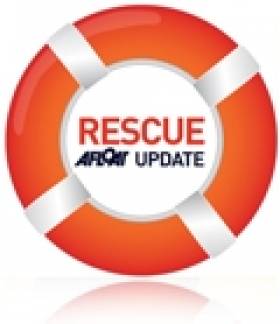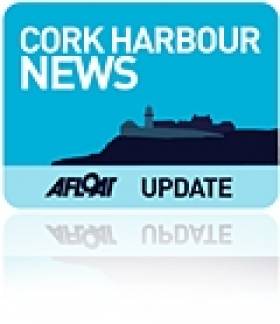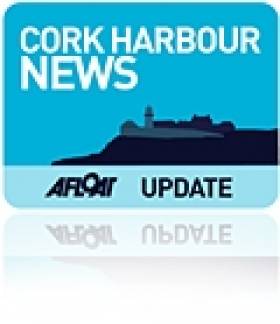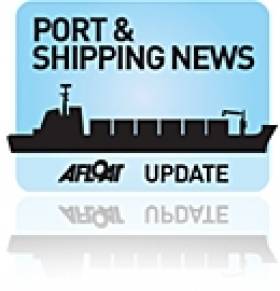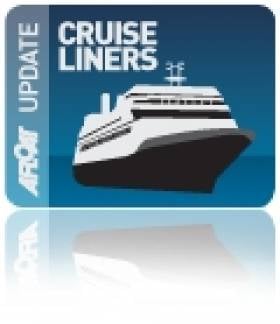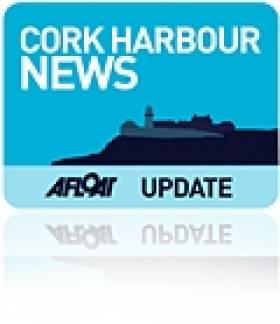Displaying items by tag: NMCI
#arctic – Cork Institute of Technology, through its Nimbus Centre and the Halpin Centre for Research & Innovation at the National Maritime College of Ireland, is to become a global leader in training small-craft mariners who work in extremely challenging Arctic conditions.
As the Arctic region continues to open up to shipping, cruise, fishing exploration and leisure boat activities, there is now an urgent need for safety and emergency response training for mariners. While regulated training is widely available for large vessel crews, this is not the situation for small craft mariners who find it generally difficult to access Arctic-specific training.
The Small Craft Emergency Response and Survival Training for Arctic Conditions or SMACS Project aims to fill this gap by developing a safety and emergency response training programme specifically focused on the needs of small craft mariners. Uptake of this training programme will make the Arctic a safer location for small craft maritime activity.
CIT is leading the SMACs project along with Chalmers University in Sweden and MSSTC in Iceland. The other partners are frontline Arctic Search and Rescue agencies, SSRS the Swedish maritime search and rescue organisation and NSSR, the Norwegian SAR agency. SMACS also has associated partners in Greenland, Norway, Faeroes and Ireland.
A Memorandum of Understanding has been signed between the NMCI Acting Head of College, Michael Delaney, Associate Head of NMCI, Cdr Dave Barry and Randy Billard, CTO of Virtual Marine Technology, and it represents yet another progression in simulation research and development ensuring that both NMCI and VMT remain at the leading edge.
Mr Delaney said "We are delighted to be working with VMT in the development of new and innovative simulation technologies the use of which continues to place the NMCI at the cutting edge as regards the use of simulation as an education and training tool.
Virtual Marine Technology based in St John's, Newfoundland and Labrador develops small craft simulators for the offshore and defence industries and specialise in harsh environmental conditions simulation. VMT's simulators are internationally certified for small craft training and incorporate advanced ice models that have been rigorously tested by ice experts from the St John's Ocean Technology Cluster.
"We are privileged to have been selected to bring our expertise in ice simulation to such a prestigious maritime development team" said Randy Billard, CTO for VMT. "We believe that Northern Europe, with its similar operational environment, can benefit from the advanced training technologies we have developed in Newfoundland and Labrador."
Simulation will be used as a training tool. Through the Halpin Centre at NMCI and the NIMBUS Centre. The SMACs project will work with VMT to validate the fidelity and performance of a lifeboat and ice environments simulator prototype being developed by VMT. The Halpin Centre at NMCI will also jointly develop with VMT a simulation based training curriculum for operators in emergency evacuation and rescue scenarios. Both the Halpin Centre at NMCI and VMT will jointly publish the results of research undertaken using this simulation technology.
The programme is funded under the EU Northern Periphery Programme (www.northernperiphery.eu ) and supported by the European Regional Development Fund
#NMCI – The President of Cork Institute of Technology, Dr Brendan Murphy, speaking at Conferrings at The National Maritime College of Ireland at Ringaskiddy in Cork Harbour today, Thursday, June 20th, said that nine years on since opening, the NMCI could be seen to have come of age.
Degrees awarded included BSc in Nautical Science, Bachelor of Engineering in Marine & Plant Engineering and Bachelor of Arts in Leadership Management & Naval Studies. Over 50 students received their parchments.
Dr Murphy said the shared vision of maritime education, training and professional development by CIT, the Irish Naval Service and the Department of Education and Defence ensures that the education available at the NMCI is world class. "This National Centre represents a state investment of the order of €50 million in Maritime Education and Training. During the last two years R&D activity has attracted funding for over ten projects – this activity now involves ten full-time personnel: the growth in R&D has led to the establishment of the Halpin Centre for Research & Innovation. NMCI Services offers specialist maritime training and consultancy both at home and abroad and the new, dedicated, Bridge Simulation Team will ensure that we capitalise on the extensive simulation facilities available here.
The continued development of the proposed Maritime and Energy Resource Cluster (IMERC) involving a partnership between CIT, the Naval Service and UCC provides a focus within Ireland for applied research and enterprise development in the maritime and energy sector."
Dr Murphy continued "It is now clear that the future of CIT, its students and staff is the creation, in partnership with IT Tralee, of the multi-campus Munster Technological University. CIT and IT Tralee have a shared vision for the creation of the MTU which will result in a new university which will build on the strengths of the existing partners and will deliver significant added value via an expanded and enhanced role in regional development."
Dr Murphy offered his congratulations to the Graduates on their achievements and wished them well in to the future.
Expansion On The Cards For National Maritime College
#NMCI - The National Maritime College of Ireland (NMCI) is to expand into Asia and the Middle East, as The Irish Times reports.
The Cork Harbour-based college, which provides training and education for the Merchant Marine and non-military needs of the Naval Service, is set to provide training and consultancy services in the Gulf region, Vietnam and Malaysia via its commercial wing NMCI Services.
That was the message from Dr Brendan Murphy, president of the Cork Institute of Technology (CIT) of which the NMCI is a constituent college.
Speaking at a conferring ceremony for new graduates, he added that 10 full-time research posts created at the NMCI in the past year represented a "growth in R&D" that "has warranted the establishment and branding of NMCI's own research centre, something which will take place in the very near future."
Countdown to Cork Harbour Open Weekend
#CORK HARBOUR – The Cork Harbour Open Weekend (15 & 16th September) as previously reported on Afloat.ie, will be a fun-filled action packed programme for all with activities on and off the water.
The weekend is a great opportunity for people to see exactly what Cork Harbour has to offer, with the second largest natural harbour in the world playing host to the annual Cobh to Blackrock sailing race, kayaking on the River Lee, crab fishing in Cobh and a free open day at the National Maritime College of Ireland (NMCI) in Ringaskiddy.
In Cork city, the Irish Naval Service CPV L.E.Ciara (P41) will be open to the public for free tours on the Saturday and Sunday.
To celebrate Cork Harbour Open Weekend, Spike Island is offering a family day out on the Island with live music, children's entertainers and an opportunity to walk on the recently completed Walking Trail around the perimeter of Fort Mitchell with stunning views of Cork Harbour.
For the latest news and of the other programme activities and events lined-up for the weekend, click HERE.
A downloadable programme including a map of the free ferry shuttle running (both days 12noon-3pm) throughout the harbour will help in planning a visit. For further details of the ferry, click HERE.
Ardmore Shipping Supports Cadetship Programme
#IRISH CADETSHIPS – Ardmore Shipping Ltd which operates a fleet of tankers on a global basis is taking part in the Irish Cadet Training Programme run by the National Maritime College of Ireland (NMCI), writes Jehan Ashmore.
The Irish registered company only set-up its international fiscal operations in 2010 at the group's head-office based in Cork. The company has provided a number of berths on its vessels for cadets in order to give them the hands-on experience that is such a vital part of their training.
One of the cadets studying at NMCI is Ian Fitzpatrick from Dublin who said: "I am very grateful for the opportunity given to me to work with a company like Ardmore Shipping on an Irish owned vessel".
Ireland has a long tradition of seafaring and with new companies like Ardmore Shipping they will give the opportunities to Irish cadets to learn and progress in their careers says the NMCI.
Ardmore is expanding its fleet with an order for four 50,000 dwt product and chemical tankers from the SPP Shipbuilding Co., Ltd, South Korea. The newbuilds are due to be completed next year and to be registered in the Marshall Islands.
Admiral Brown's Mayo Naval Connections
#ADMIRAL BROWN – In addition to the 155th anniversary commemoration of the death of Admiral William Brown which was held in the Argentinian capital at the weekend, as previously reported on Afloat.ie, a second ceremony was held in Foxford, Co. Mayo, the birthplace of the admiral who founded the navy of the South American country.
In attendance were the Argentine Ambassador, Dr. Maria Bondanza, with Argentine Naval Attache, Group Captain Alejandro Amoros, and Irish Naval Service Commodore, Mark Mellett. For more about this story as reported by MayoToday click HERE.
Commodore Mellett who also hails from Co. Mayo was appointed Flag Officer Commanding the Naval Service (FOCNS) following the retirement of Commodore Frank Lynch in December 2010.
The Mayo native will be addressing delegates this Friday at the inaugural IMERC Conference on Maritime Geostrategic Thinking for Ireland at the National Maritime College of Ireland (NMCI) in Ringaskiddy.
IMERC which stands for the Irish Maritime and Energy Resource Cluster will host the conference in the college where guided tours of the facility will also be made available during the one-day conference. The conference is open to the public and free of charge, for more information including conference agenda click HERE.
IMERC’s Inaugural Conference 2012
#IMERC CONFERENCE - The recently established Irish Maritime and Energy Resource Cluster (IMERC) which is to promote the country as a world-renowned research and development location, is to host next month its inaugural conference entitled 'Maritime Geostrategic Thinking for Ireland'.
Minster for Marine, Simon Coveney T.D. will address the conference at the National Maritime College of Ireland (NMCI), Ringaskiddy, Co, Cork which is to be held on Friday 9th March.
In addition to keynotes speakers addressing the conference are Glenn Murphy (IMDO), Commodore Mellett of the Naval Service, Anthony Gurnee from Ardmore Shipping, Helen Noble, Head of Maritime Law at Matheson Ormsby and Prentice and Professor D John Mangan from the University of Newcastle.
Below is a programme schedule of the conference and additional information and link.
Session 1: Fighting recession by supporting an export led economy
Session 2: Building maritime security capability in support of economic development
Session 3: Future of Maritime Ireland
Session 4: IMERC Industry Engagement
To make a booking and receive further details on the conference contact IMERC Tel: (021) 433 5717 or by clicking HERE.
IMERC is based on the campus grounds of NMCI which is located between the Naval Service Base on Haulbowline Island and the neighbouring ferryport in Ringaskiddy.
Under phrase 1 of IMERC's campus development plans, it aims for the construction of the UCC National Beaufort Centre by May 2013. Phase 2 of the campus is for an extended maritime and energy science and commercial park located on the adjacent Port of Cork owned landbank.
A Tale of Two Sisters: Cobh’s Former Liner Tenders
#LINER TENDERS – As Dubliners and visitors alike enjoy the facilities of Cill Airne, the River Liffey's floating restaurant and bar venue, her sister, Canima is in complete contrast, as she rusts away on the far side of the Atlantic, writes Jehan Ashmore.
The Camina was originally launched as Blarna along with Cill Airne from the Liffey Dockyard in the early 1960's as passenger tenders serving the trans-Atlantic liners out of Cobh for the Cork Harbour Commissioners. The 1,000 passenger capacity sisters, each around 500 gross tonnes, were the last vessels to be built using riveted hull constructed methods in Europe.
With the collapse of the liner trade and proliferation of the jetliner in the early 1970's, they had served short careers in Cobh. Blarna was sold to North American interests while Cill Airne remained in Irish waters. She was sold to the Cork Institute of Technology for radar and navigation training on the River Lee and Cork Harbour.
By 2003 Cill Airne's days were numbered as she became obsolete when high-tech simulators formed part of the National Maritime College of Ireland (NMCI) in Ringaskiddy.
She was sold to Dublin investors in 2006 having completed an extensive restoration project at Hegarty's Boatyard in West Cork. She reflects her liner era heritage with art-deco fittings, wood panelling and timber decks throughout, for more click HERE.
As for Blarna, she later served in Bermuda which lasted until 1988. To read more on what her former captain from the Bermudian career has to say on her fate in Canada, where there are plans to secure her future as reported on the RoyalGazette, click HERE.
NMCI Open Day: Let’s Sea What You’re Made Of
The open day is primarily aimed at fourth-year transition and leaving certicifcate students. For further information, enquiries and bookings for groups contact NMCI Tel: (021) 497 0607 by email: [email protected] and also the website: www.nmci.ie
Road, Rail or ‘Sail’ to Cobh
There's also the option of departing Cork-city centre to Cobh by taking an excursion on the River Lee on the passenger-tender Spirit of the Isles. Sailings depart the city's Penrose Quay, which is on the same side to the railway (Kent) station.
Sailings will operate this Saturday and Sunday and for the remaining weekends throughout September. The boat's Saturday schedule departs the city at 11am and arrives at Cobh's Kennedy Quay at 12.15pm.
In addition there is a Lower harbour tour off Cobh on Saturdays and Sundays, departing Kennedy Pier, Cobh - 12.30pm and returning to Kennedy Pier at 1.45pm. The boat then departs Cobh at 2pm to return to Cork with an arrival time of 3.15pm. For both this Saturday and Sunday sailing schedules, fares and further information go to www.corkharbourcruises.com
In the late 1980's the Spirit of the Isles then named Ingot operated excursions for several seasons from Dun Laoghaire's East Pier to Dalkey Sound and Killiney Bay.
Returning to the third annual Cork Harbour Open Day there will also be a free shuttle-service running in the lower harbour calling at Ringaskiddy, Monkstown, Cobh, Aghada and Crosshaven. The fast-ferry RIB operator 'Whale of a Time' is providing the free service which is sponsored by the Port of Cork Company and National Maritime College of Ireland (NMCI). For further information visit http://www.whaleofatime.net/Home.html
- Dun Laoghaire
- Cork Harbour
- port of Cork
- Cruise Liners
- River Lee
- Cork Harbour Open Day
- NMCI
- Cobh Cruise Terminal
- National Maritime College of Ireland (NMCI)
- Ports and Shipping News
- Cork Harbour News
- Irish Rail
- Port of Cork Company
- Cunard Line
- Queen Elizabeth
- Whale of a Time
- Cruise Liner news
- Dalkey Sound
- Cruise ship news
- Midelton Food & Drink Festival
- Ingot
- Killiney Bay
- Irish passenger excursion vessels
- Cork Harbour Cruises
- CorkCobh
- Cork (Kent) station
- Spirit of the Isles


























